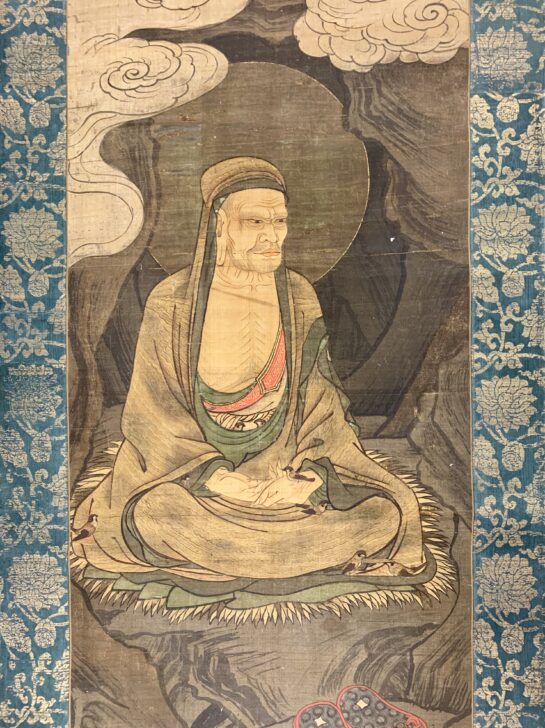Arhat Meditating in a Cave (one of a pair)
Japanese

Description
Copies and Invention in East Asia (August 17, 2019 - January 5, 2020)
Veneration of arhats—immortal disciples of the Buddha who have attained enlightenment and help spread Buddhist teachings—began in China, but spread throughout East Asia, becoming particularly linked with Chan/Zen Buddhism. Images of arhats are often found in temples, where an entire hall might be devoted to displaying multitudes of arhats. The two paintings on view here are likely from a temple.
Winter 2015 Gallery Rotation
In the Buddhist tradition, arhats are beings who have attained nirvana in life and will achieve final liberation, or release from the cycle of rebirth, at death. The historical Buddha is said to have selected certain arhats, traditionally numbering sixteen, to remain in the world after his death and disseminate his teachings until the arrival Maitreya, the Buddha of the future. These arhats are objects of devotion in the East Asian tradition and are almost always worshipped as a group rather than individually. In Japan, worship of the arhats began around the twelfth century.
In paintings, arhats are traditionally depicted as monks with shaved heads and loose robes, as they are here. The ring of light surrounding the head signifies an elevated status and the attainment of enlightenment. The arhat holding a small structure is likely Subinda, the last arhat to come to the Buddha. He is said to carry a pagoda, a structure used in early Buddhism to house the ashes of the historical Buddha; this would have served as a reminder of the Buddha and his teachings. The seated monk holds his hands in a gesture of concentration as he meditates; birds are beginning to flock to him, possibly drawn by his enlightened spirit. In Buddhism, animals are believed capable of attaining enlightenment, so it is possible that by accompanying a meditating arhat, the birds can further their own path to enlightenment. The figure with long white eyebrows and a head covering is likely the arhat Ajita. Subinda and Ajita are two of the sixteen great arhats.
Subject Matter:
In paintings, arhats are traditionally depicted as monks with shaved heads and loose robes, as they are here. The ring of light surrounding the head signifies an elevated status and the attainment of enlightenment. The seated monk holds his hands in a gesture of concentration as he meditates; birds are beginning to flock to him, possibly drawn by his enlightened spirit. In Buddhism, animals are believed capable of attaining enlightenment, so it is possible that by accompanying a meditating arhat, the birds can further their own path to enlightenment. The figure with long white eyebrows and a head covering is likely the arhat Ajita.
Physical Description:
Long hanging scroll with gold and blue-green fabric surrounding the image. The image depicts a man seated in a rock cave. There is a ring around his head, and above that is smoke. A pair of red and black sandles are seen in the lower right corner of the image. The man is seated with his hands crossed and is sitting atop what appears to be straw. His robe is a faded yellow-brown with green accenting, and a piece of red along the chest. The robe covers the top of his head.
Usage Rights:
If you are interested in using an image for a publication, please visit https://umma.umich.edu/request-image/ for more information and to fill out the online Image Rights and Reproductions Request Form.